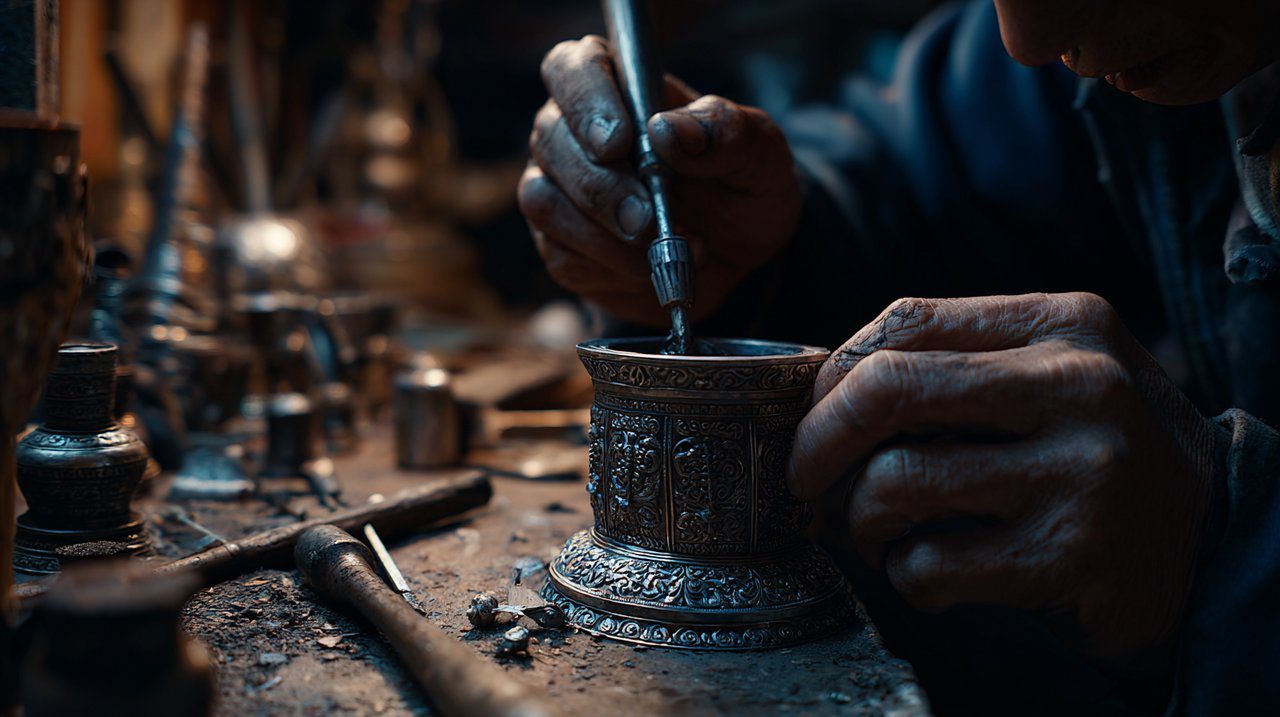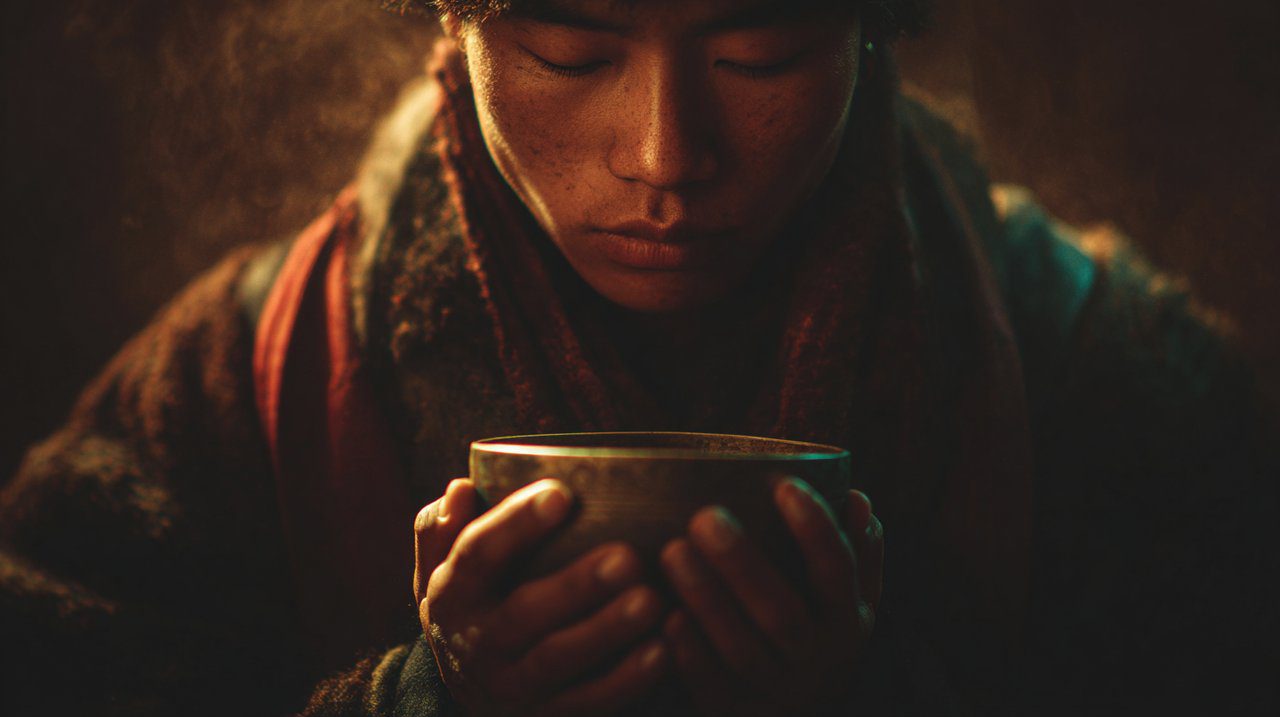The Shopenga Tibetan Gau: A Personal Sanctuary, A Mobile Monastery
In the quiet corners of Tibetan Buddhist tradition, there are objects that speak volumes without uttering a sound. The Shopenga Tibetan Gau is one such companion. This small, often beautifully crafted portable shrine, sometimes called a Tibetan prayer box or Tibetan ghau, isn’t just an adornment; it’s a testament to a spiritual path that values both profound inner meaning and tangible expressions of faith.
It acts like a silent guardian, a spiritual anchor designed to carry blessings and a sense of protection, no matter where our journey takes us.
nn
The Shopenga Tibetan Gau: A Legacy of Faith and Craftsmanship
Origins and Development
The journey of the Tibetan gau began centuries ago, much like a river carving its path through time. Its earliest forms were born from necessity, used by nomadic practitioners to safeguard precious relics and sacred substances.
Imagine these early travelers, moving across the vast, windswept Tibetan plateau. Their Gaus were sturdy vessels, protecting the most sacred elements from the harsh elements, much like a mountain shelters a delicate flower.
As the roots of Buddhism deepened and spread, the Shopenga Tibetan box began to transform. It evolved from a simple container into something more intricate, becoming a significant piece of Tibetan jewelry. This evolution mirrors the spiritual journey itself – a continuous refinement, growing in beauty and depth.
Each curve and embellishment on a Gau tells a story of devotion and the enduring human desire to carry a piece of the sacred close at hand.
The Art of the Gau Maker
The creation of a Tibetan ghau is a revered craft, often passed down through generations, much like a secret whispered from elder to apprentice. These skilled artisans work with silver, copper, or gold, meticulously shaping the distinctive box-like forms.
Their work is more than just technical skill; it’s a meditative act. Each careful hammer stroke, each delicate engraving, is imbued with spiritual intention, contributing to the object’s sacred purpose, much like a gardener tending to a precious sapling.
Artisans often adorn the gau Tibet with precious and semi-precious stones like turquoise and coral. These aren’t chosen merely for their beauty, but for their specific symbolic significance within Tibetan culture. The careful selection of materials and the precision of the workmanship ensure that each Tibetan prayer box is not only visually appealing but also a durable vessel, ready to hold its sacred contents for generations.
n n
n
Decoding the Sacred: Symbolism and Contents
The Gau as a Microcosm of a Mobile Monastery
Within its compact form, the Shopenga Tibetan gau is envisioned as a miniature temple, a divine dwelling place. It’s a microcosm of a mobile monastery, representing the sacred abode of deities or enlightened beings.
Think of it as a personal sanctuary that travels with you, like a quiet alcove in a vast forest. It allows individuals to carry a piece of their spiritual world, offering solace regardless of their physical location.
This concept reminds us that sacred space isn’t confined to grand structures; it can be manifested and carried personally. While its exterior might be ornate, its true power lies in its ability to contain and radiate blessings from within, functioning as a personal sanctuary in miniature.
Holy Relics and Protective Charms
What truly gives a Tibetan gau its potency are the sacred contents it holds within. These vary widely, reflecting an individual’s spiritual path and the blessings received from revered lamas.
- Blessed pills (rilbu) made from sacred substances.
- Small, rolled-up mantra scrolls.
- Tiny clay tsa-tsa stupas or deity images.
- Pieces of sacred cloth or hair from revered teachers.
- And most notably, dzi beads, cherished for their protective qualities and spiritual energy.
These are not just objects; they are conduits of spiritual energy, offering protection, promoting well-being, and aiding in the accumulation of merit. The Tibetan prayer box acts as a guardian for these precious relics, making their blessings accessible at all times, much like a portable spiritual battery for the soul.
Designs as Devotion: Exploring Diverse Aesthetics
Materials, Motifs, and Regional Variations
The Tibetan ghau design showcases a remarkable diversity, reflecting the unique artistic traditions of different regions and the personal preferences of its owner. The materials used range from humble copper to elaborate silver and gold, often inlaid with vibrant turquoise, coral, lapis lazuli, or amber.
These stones are chosen not just for their inherent beauty but for their specific energetic and symbolic properties, much like different plants have different healing qualities. Common decorative motifs include the Eight Auspicious Symbols (Tashi Tagye), the dorje (vajra), endless knots, and intricate floral patterns.
Each symbol carries layers of meaning, reinforcing the protective and auspicious nature of the Tibetan prayer box. You might observe simpler, sturdier designs preferred by nomads, contrasting with the more elaborate and finely detailed styles found in urban or monastic settings.
From Personal Amulet to Artistic Statement
While primarily a spiritual tool, the Shopenga Tibetan gau also serves as a powerful artistic expression. Its craftsmanship elevates it to a significant piece of Tibetan jewelry, often worn prominently around the neck or attached to belts.
The careful selection and artistry of a gau Tibet reflect not only the owner’s devotion but also their aesthetic sensibilities and deep connection to Tibetan culture. This duality—a deeply personal sacred container and a public display of faith and artistry—highlights its unique place in Tibetan spiritual and material culture. It bridges the gap between our inner spiritual journey and its external manifestation, much like a tree’s roots unseen, yet its branches reach for the sky.
The Gau in Practice: A Portable Altar for the Modern World
Daily Ritual and Spiritual Connection
For many, the Shopenga Tibetan gau is a constant companion, a tangible link to their spiritual practice throughout the day. Its presence offers a passive sense of protection, yet it can also be actively woven into personal rituals.
Imagine a practitioner navigating the bustling city streets or traversing remote mountain passes. A brief moment to touch their Gau, feeling its smooth metal and the blessings held within, offers immediate solace. It’s a quiet reminder of their spiritual path, like catching a glimpse of a familiar peak on the horizon.
Unlike the repetitive chanting aided by mala beads or the turning of Tibetan prayer wheels for accumulating merit, the Gau’s role is often more about containment, presence, and carrying blessings. It provides a focal point for mindfulness and a gentle reminder of one’s vows and aspirations. Carrying a Tibetan prayer box is a deeply personal act, a quiet affirmation of faith in a bustling world, ensuring that sacred space is always within reach, like carrying a small, calm pool of water in a desert.
n n
n
Preserving Tradition, Embracing the Future
In our increasingly interconnected world, the Tibetan ghau continues to hold immense cultural and spiritual significance. It represents a living tradition, connecting contemporary practitioners to an ancient lineage, much like an old growth forest connects new saplings to generations past.
Its appeal lies in its ability to offer personal solace, protection, and a tangible link to spiritual heritage. As interest in Tibetan Buddhism expands globally, the Shopenga Tibetan gau stands as a powerful symbol of devotion, craftsmanship, and the universal human desire to carry the sacred close.
It serves as a bridge, inviting individuals to delve into a rich spiritual path and appreciate the wisdom it offers. The Shopenga Tibetan Gau is far more than an object; it is a journey encapsulated. From its ancient origins to its intricate designs and sacred contents, it embodies a living tradition of faith and artistry. Carrying a Tibetan prayer box means carrying a piece of the sacred, a personal sanctuary that accompanies you, offering protection and a constant connection to a deeper spiritual path.
Consider how this unique piece of Tibetan jewelry could enrich your own spiritual journey, offering a tangible link to an ancient and vibrant culture.
💡 الأسئلة المتكررة
A Shopenga Tibetan Gau, also known as a Tibetan prayer box or Tibetan ghau, is a small, portable shrine or container. Its primary purpose is to safeguard precious relics, sacred substances, mantras, and images, acting as a personal sanctuary and spiritual anchor that practitioners can carry with them.
The Tibetan Gau originated centuries ago as sturdy vessels for nomadic practitioners to protect sacred items from harsh conditions. It evolved from a simple container into an intricate piece of Tibetan jewelry, mirroring the spiritual journey of continuous refinement, growing in beauty and depth. This transformation signifies the deepening of Buddhist practice and the integration of faith into personal adornment.
Typical contents of a Tibetan Gau include blessed pills (rilbu), rolled-up mantra scrolls, small clay tsa-tsa stupas or deity images, pieces of sacred cloth or hair from revered teachers, and cherished dzi beads known for their protective qualities. These items are considered conduits of spiritual energy.
The Tibetan Gau is also a significant piece of Tibetan jewelry, showcasing diverse artistic traditions and craftsmanship. They are often made from silver, copper, or gold, inlaid with semi-precious stones like turquoise and coral, and decorated with motifs like the Eight Auspicious Symbols or dorje. The artistry reflects the owner's devotion and aesthetic sensibilities.
In daily practice, a Tibetan Gau serves as a constant companion and a tangible link to spiritual practice, offering a passive sense of protection and solace. It can be actively used as a focal point for mindfulness or a gentle reminder of one's vows and aspirations, providing a portable altar or sacred space.








